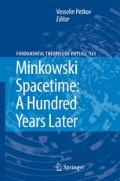Abstract
An often repeated account of the genesis of special relativity tells us that relativity theory was to a considerable extent the fruit of an operationalist philosophy of science. Indeed, Einstein’s 1905 paper stresses the importance of rods and clocks for giving concrete physical content to spatial and temporal notions. I argue, however, that it would be a mistake to read too much into this. Einstein’s operationalist remarks should be seen as serving rhetoric purposes rather than as attempts to promulgate a particular philosophical position – in fact, Einstein never came close to operationalism in any of his philosophical writings. By focussing on what could actually be measured with rods and clocks Einstein shed doubt on the empirical status of a number of pre-relativistic concepts, with the intention to persuade his readers that the applicability of these concepts was not obvious. This rhetoric manoeuvre has not always been rightly appreciated in the philosophy of physics. Thus, the influence of operationalist misinterpretations, according to which associated operations strictly define what a concept means, can still be felt in present-day discussions about the conventionality of simultaneity.The standard story continues by pointing out that Minkowski in 1908 supplanted Einstein’s approach with a realist spacetime account that has no room for a foundational role of rods and clocks: relativity theory became a description of a four-dimensional “absolute world.” As it turns out, however, it is not at all clear that Minkowski was proposing a substantivalist position with respect to spacetime. On the contrary, it seems that from a philosophical point of view Minkowski’s general position was not very unlike the one in the back of Einstein’s mind. However, in Minkowski’s formulation of special relativity it becomes more explicit that the content of spatiotemporal concepts relates to considerations about the form of physical laws. If accepted, this position has important consequences for the discussion about the conventionality of simultaneity.
Access this chapter
Tax calculation will be finalised at checkout
Purchases are for personal use only
Preview
Unable to display preview. Download preview PDF.
References
Bridgman, P.W.: ‘Einstein’s Theories and the Operational Point of View’, pp. 333–355 in Schilpp (1949)
Brown, H.R.: Physical Relativity. Clarendon, Oxford (2005)
Dieks, D.: The “reality” of the Lorentz contraction. Zeitschrift für allgemeine Wissenschaftstheorie 15, 33–45 (1984)
Dieks, D.: Gravitation as a universal force. Synthese 73, 381–397 (1987)
Dieks, D.: Space and time in particle and field physics. Stud. Hist. Phil. Mod. Phys. 32, 217–242 (2001)
Dieks, D.: Space, time and coordinates in a rotating world. In: Rizzi, G., Ruggiero, M.L. (eds.) Relativity in Rotating Frames, pp. 29–42. Kluwer, Dordrecht (2004)
Earman, J.: World Enough and Space Time. MIT Press, Cambridge, MA (1989)
Einstein, A.: Zur Elektrodynamik bewegter Körper. Annalen der Physik 17, 891–921 (1905)
Einstein, A.: Über das Relativitätsprinzip und die aus demselben gezogen Folgerungen. Jahrbuch der Radioaktivität und Elektronik 4, 411–462 (1907)
Einstein, A.: Le Principe de Relativité et ses Conséquences dans la Physique Moderne. Archives des sciences physiques et naturelles 29, 5–28/125–144 (1910)
Einstein, A.: Die Relativitätstheorie. Naturforschende Gesellschaft in Zürich. Vierteljahrsschrift 56, 1–14 (1911)
Einstein, A.: Geometrie und Erfahrung. Julius Springer, Berlin (1921)
Einstein, A.: Nichteuklidische Geometrie und Physik. Die neue Rundschau 1, 16–20 (1925)
Einstein, A.: Ideas and Opinions. Crown Publishers, New York (1954)
Howard, D.: ‘Einstein and the Development of Twentieth-Century Philosophy of Science’, to appear in The Cambridge Companion to Einstein (2007)
Klein, M.J., Kox, A.J., Renn, J., Schulmann, R. (eds.): The Collected Papers of Albert Einstein, vol. 3. Princeton University Press, Princeton, NJ (1993)
Lorentz, H.A., Einstein, A., Minkowski, H., Weyl, H.: The Principle of Relativity. Methuen, London (1923) (First republished as a Dover edition in 1952, Dover, New York)
Lynden-Bell, D.: A relative Newtonian mechanics. In: Barbour, J., Pfister, H. (eds.) Mach’s Principle from Newton’s Bucket to Quantum Gravity, pp. 172–178. Birkhäuser, Basel (1995)
Minkowski, H.: Raum und Zeit. Physikalische Zeitschrift 10, 104–111 (1909)
Reichenbach, H.: ‘The Philosophical Significance of the Theory of Relativity’, in Schilpp (1949), pp. 287–313 (1949)
Reichenbach, H.: The Philosophy of Space and Time. Dover, New York (1957) (Original German version: Philosophie der Raum-Zeit-Lehre. Walter de Gruyter, Berlin (1928))
Schlick, M.: Space and Time in Contemporary Physics. Oxford University Press, Oxford (1920) (Original German version: Raum und Zeit in der gegenwärtigen Physik. Julius Springer, Berlin (1917))
Schilpp, P.A. (ed.): Albert Einstein: Philosopher-Scientist. Open Court, La Salle (1949)
Stachel, J., Cassidy, D.C., Renn, J., Schulmann, R. (eds.): The Collected Papers of Albert Einstein, vol. 2. Princeton University Press, Princeton, NJ (1989)
Teller, P.: Space-time as a physical quantity. In: Achinstein, P., Kagon, R. (eds.) Kelvin’s Baltimore Lectures and Modern Theoretical Physics. MIT Press, Cambridge, MA (1987)
Walter, S.: Minkowski, Mathematicians, and the Mathematical Theory of Relativity, pp. 45–86. In: Goenner, H., Renn, J., Ritter, J., Sauer, T. (eds.) The Expanding Worlds of General Relativity. Birkhäuser, Boston/Basel (1999)
Author information
Authors and Affiliations
Corresponding author
Editor information
Editors and Affiliations
Rights and permissions
Copyright information
© 2010 Springer Science+Business Media B.V.
About this chapter
Cite this chapter
Dieks, D. (2010). The Adolescence of Relativity: Einstein, Minkowski, and the Philosophy of Space and Time. In: Petkov, V. (eds) Minkowski Spacetime: A Hundred Years Later. Fundamental Theories of Physics, vol 165. Springer, Dordrecht. https://doi.org/10.1007/978-90-481-3475-5_9
Download citation
DOI: https://doi.org/10.1007/978-90-481-3475-5_9
Published:
Publisher Name: Springer, Dordrecht
Print ISBN: 978-90-481-3474-8
Online ISBN: 978-90-481-3475-5
eBook Packages: Physics and AstronomyPhysics and Astronomy (R0)

